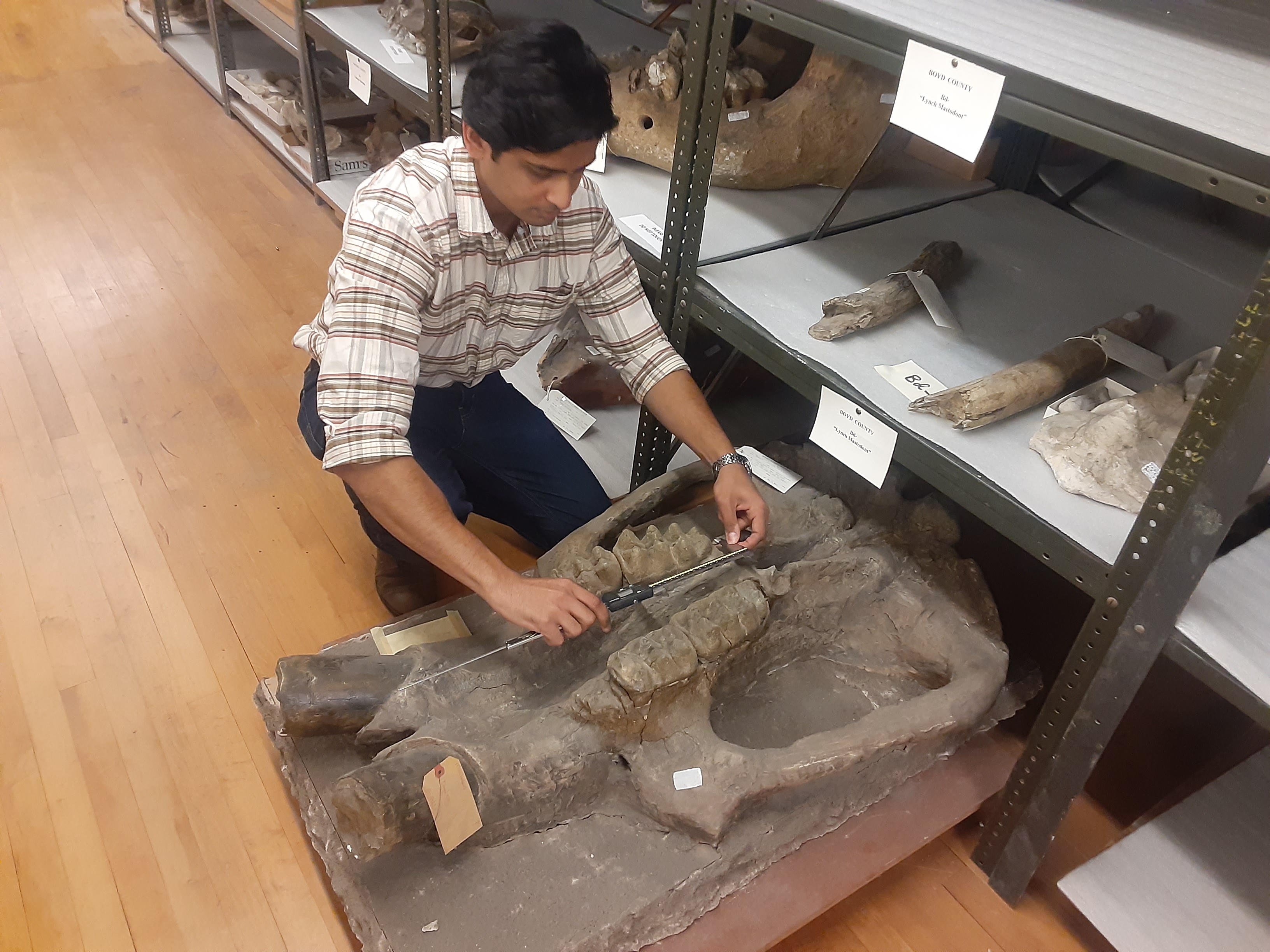
Smithsonian researcher visits University of Nebraska State Museum to solve mystery
What career lets you travel through time, solve mysteries and engage in science? Hint: the correct answer is not a science fiction novel detective. It’s paleontology. However, paleontologists also serve as historians, educators and story tellers. At least, that’s how Dr. Advait Jukar with the Smithsonian Institution’s National Museum of Natural History sees it. He recently spent several days in the University of Nebraska State Museum’s (UNSM) fossil collection trying to solve a mystery.
Today, only three species of elephant exist on earth. But 30,000 years ago, 17 different elephant species lived on the planet. Seven of those species lived in North America. That’s why it’s not unusual to find elephant or mammoth teeth, bones or fossils in locations across the continental United States. In fact, Dr. Jukar is using many of those finds as evidence.
“There’s a skull from Hagerman, Idaho that has never been studied before,” Dr. Jukar said. “It’s in our collection at the Smithsonian, and it’s morphologically really interesting. It’s not typical of what we’d expect of the American Mastodon, but it’s also not what we’d expect of these other primitive mastodons that we’ve found in North America. So what is this thing and where did it come from?”
Adding to the drama, Dr. Jukar said there’s only one known skull of this type. He’s traveling to different museums, looking through their fossil collections, and examining teeth and isolated remains to try and determine where this skull may fit into a larger family tree of mastodons.
“Teeth are some of the most commonly preserved fossils because tooth enamel preserves very well,” Dr. Jukar said. “It’s a very hard and durable substance. But teeth can be variable.”
That variability is what brought Dr. Jukar to UNSM. He’s studying fossilized teeth in the Museum’s collection to understand what the normal variation is on different mastodon teeth. Hopefully that will help him determine which specie groups his mystery skull most closely allies with.
“UNL has one of the best fossil elephant collections on the planet,” Dr. Jukar said. “If you go back 12,000 years you would have seen Archie the mammoth or equivalents wandering around the Nebraska Prairie with herds of bison, elk, horses, camels, all kinds of things like that.”
George Corner, collections manager for UNSM, estimates more than 1,000 elephant and mammoth teeth are kept in the Museum’s collection. According to Dr. Jukar, when dealing with fossils, having more matters.
“In order to get robust statistical results, we need a lot of samples. It’s always good to have one thing, but that just becomes an anecdote. When you have more things you can say, ‘Oh this is a repeated pattern.’ It is a way for us to get at the truth.”
The truth behind of the origins of the skull from Hagerman, Idaho remains elusive. But Dr. Jukar said he will continue researching, and he hopes the public understands the hunt is about more than just one skull.
“A lot of what we do (paleontology) is purely scientific. We have these academic questions about the evolution of life. In the larger picture I think people want to know where we come from and why the world is the way it is, and really the only way to figure this out is by going back in time. I get to travel back in time with these animals and understand why Nebraska was the way it was 15 million years ago and why it looks the way it is now.”
In Corner’s opinion, museums contribute to the overall story by preserving collections for future research and engaging the public. He hopes more students and families will take time to explore exhibits.
“If a student is interested in what’s around them, who knows what curiosity you’re unlocking,” Corner said. “If just one kid is motivated, that’s great; that’s what education is all about.”
Dr. Jukar agrees. Educational outreach is why he helped develop several hands-on activities related to fossils and evolutionary trees. UNSM used several of the activities in recent fossil events and will continue using them to converse with the public about evolution and fossils in the future.
“It makes a world of difference when kids can actually handle a specimen, hold it in their hands, see what it is, and then do some actual science,” Dr. Jukar said. “Our hope is to inspire them to be curious about the world and to start thinking about how science is done and the length of time and diversity of life. Time is a very abstract concept, but fossils can let people hold a piece of it.”
More details at: http://museum.unl.edu